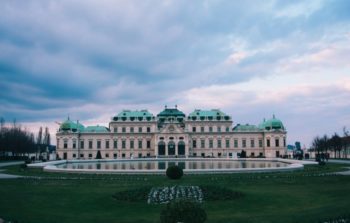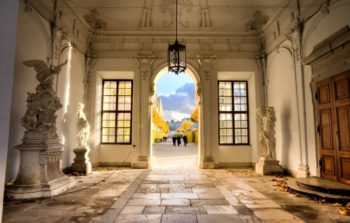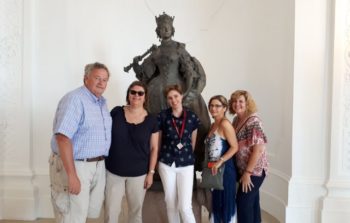Itinerary

Belvedere Palace, an 18th-century architectural masterpiece
The Belvedere complex is an architectural masterpiece of bygone aristocratic splendor, designed to project a sense of earthly harmony. This terrestrial utopia was founded in the first decades of the 18th century as a summer residence for Prince Eugene of Savoy, the commander-in-chief of the Austrian army and one of the most successful military commanders in modern European history.
During our tour, we explore the formal gardens, the Upper Belevedere, and the museum, with the option of visiting the Lower Belvedere’s temporary exhibition and the Orangery at your own pace – depending on ticket type.

The Formal Gardens
Our Belvedere Palace walking tour begins in the formal gardens, where your expert historian guide shares insight into highlights including the great water basin in the upper parterre, the tiered fountains and cascades populated by nymphs and goddesses, the marble statues of gods and heroes, and the intricate wrought iron gates. Inspired by classical antiquity, Belvedere Palace’s gardens testify to the legacy of Prince Eugene’s dedicated patronage of the Arts.
 The Upper Belvedere and the Prince’s Summer Residence
The Upper Belvedere and the Prince’s Summer Residence
Among the most significant buildings of its time, the grandiose palace of the Upper Belvedere is a masterstroke of Baroque architecture. With your knowledgeable guide to lead the way, explore the Prince’s summer residence and learn how the elegant sala terrena, grand staircase, majestic marble hall, and the chapel illustrate both his own personal tastes and the artistic considerations of the day.
After Eugene’s death, the complex continued to play a significant role in Austrian culture and history. Inspired by the notion of enlightened absolutism, the Belvedere became one of the first public museums in the world – with the aim of making the Habsburgs’ imperial collection accessible to the general public.

The Belvedere Museum
Following our 1-hour walk through the gardens and palace, our tour moves on to a 1.5-hour visit of the Belvedere Museum. The museum exhibits a world-class compilation of Austrian and international masterpieces from the Middle Ages to the present day, including items from the Austrian National Gallery. During your visit, your expert guide – an art and architecture historian – shares the secrets of treasured artworks by renowned artists including Gustav Klimt, Egon Schiele, Auguste Rodin, Claude Monet, and Vincent van Gogh, to name but a few.
Pieces include acclaimed paintings from Gustav Klimt’s golden period such as ‘The Kiss‘, ‘Judith and the Head of Holofernes‘, landscapes from the Attersee series, and other sophisticated portraits of high society ladies. As a counterpoint, the dramatic and contorted style of Klimt’s younger colleague, Egon Schiele, evokes the unfolding trauma of the First World War in a profoundly autobiographical manner.
Besides Klimt’s and Schiele’s great canvasses representing fin de siècle Vienna’s avant-gardism, you’ll encounter Jacques-Louis David’s well-known ‘Napoleon on The Great St. Bernard Pass‘ (1801), where the artist’s propagandist pathos blends with his fiery boldness. In a different way, Caspar David Friedrich’s atmospheric ‘Wanderer above the Sea of Fog‘ is a masterpiece of the Romantic movement, sensitively combining introspection with metaphysical symbolism.